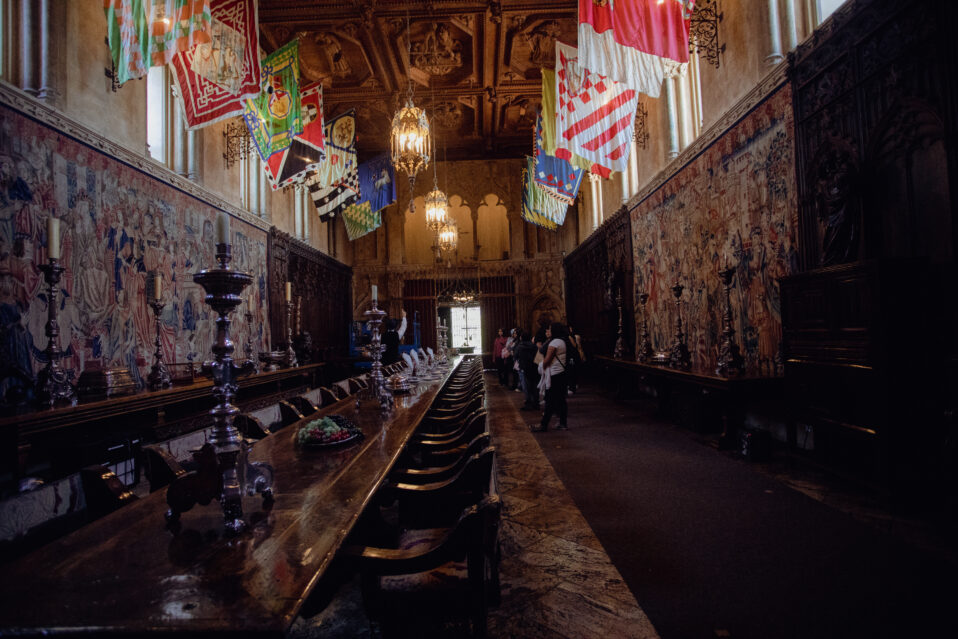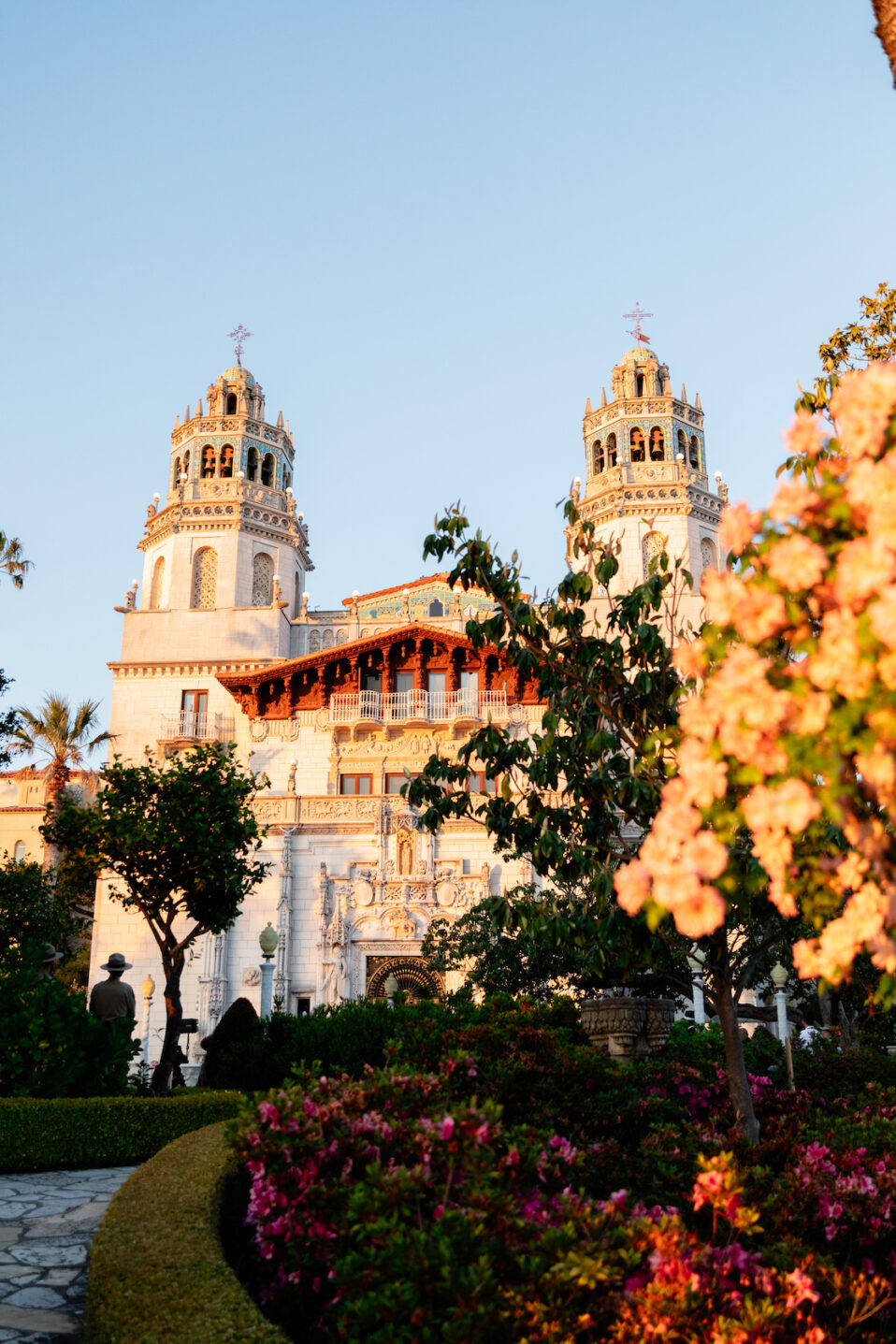As treatment of Hearst Castle’s Morning Room ceiling enters its final phase early next year, I recall how it all began a decade ago. Admired by more than 500,000 visitors a year, this ceiling is one of the most elaborate historic ceilings at Hearst Castle. It is completely painted with coats-of-arms, pseudo-Arabic script, jousting scenes, fictive portrait-busts, flowers, and birds, among many other motifs. Colorful star-shaped rosettes and their borders are made of separate elements individually tacked together.
The dotted white borders are a typical motif in the style often called Mudéjar. In architecture, Mudéjar style does not refer to a distinct architectural style, but to the application of traditional technical, ornamental and decorative elements derived from Islamic arts to Romanesque, Gothic, and Renaissance architectural styles in the Christian kingdoms of Iberia (now Spain and Portugal), mostly during the 13th, 14th and 15th centuries, although it continued to appear in Spanish and Portuguese architecture as well as in other regions, most notably Hispanic America, in the 16th and 17th centuries. Mudéjar decoration and ornamentation includes stylized calligraphy and intricate geometric and vegetal forms.
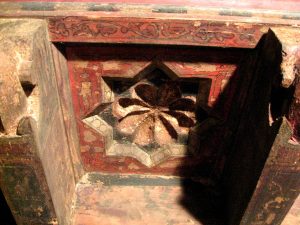
Colorful star-shaped rosettes and their borders are made of separate elements individually tacked together.
The ceiling likely came from a palace on the Plaza de la Judería in the city of Teruel, Spain, which became the Alcazar Real of Alfonso V. This palace was being renovated around 1425. Even without archival sources, an early 15th-century date for the ceiling could easily be determined by the style of the armor worn by knights in some of the vignettes, along with the rippling fluidity of the dotted borders.
In 2010, the Morning Room ceiling at Hearst Castle was at risk: hundreds of tiny flakes of 500-year-old paint were becoming detached, and layers of grime, soot, and linseed oil obscured many of the vignettes.
Gary Hulbert is the conservator who was hired on contract to conserve and reveal the myriad details and beautiful craftsmanship of this extraordinary work of art.

Gary Hulbert is the conservator who was hired on contract to to conserve and reveal the myriad details and beautiful craftsmanship of this extraordinary work of art.
On a morning in March 2010, Mr. Hulbert explained the process to board members. At that time, only a small test panel on a corbel had been cleaned, revealing a bright splash of color against a muddy-colored background. The contrast was astonishing! When Mr. Hearst purchased the ceiling, he had no way of knowing what vibrancy was hiding beneath the grime.
Mr. Hulbert also shared that the ceiling, like most other historic Spanish ceilings of that time, is made of red pine. Its flat panels, beams, and rosettes were originally sealed and smoothed with gesso before being painted with colorful scenes in egg tempera. There is also evidence of linseed oil, which was most likely applied by Mr. Hearst’s workmen.

Individual cotton swabs are moistened in a solution of distilled water, various organic cleaners, and other agents that bind with iron and dirt.

Several alternating applications of various cleaning agents loosen the dirt without affecting the paint.

All work performed by the conservator is reversible and done without compromise to the original ceiling.
Before cleaning could begin, all the loose paint flakes had to be re-adhered to prevent their detachment when the removal of grime would begin. Using a minuscule brush (see the illustration below), the conservator applied an emulsion of polyvinyl acetate (PVA) glue to the back of each flake, which was then carefully reattached with a heated tacking iron, sealing the flakes firmly into place.
Cleaning began after the loose paint was secured. This is a painstaking process carried out with individual cotton swabs which are moistened in a solution of distilled water, various organic cleaners, and other agents that bind with iron and dirt.
The conservator determines the precise mixtures to remove soot, oily nicotine from tobacco smoke, linseed oil, and dirt. Several alternating applications of various cleaning agents loosen the dirt without affecting the paint. After each cotton swab has absorbed the dirt, it must be discarded, to be replaced by a fresh, clean swab. Like most experienced conservators, Mr. Hulbert rolls his own cotton swabs on the end of a bamboo skewer cut to whatever length he needs. After cleaning was completed, he applied a thin, invisible veil of protective varnish.
Next, he painted in the selected areas where flaking revealed bare wood. This process (in-painting) is considered carefully to preserve the sense of age through loss: the ceiling must not appear to have been completely repainted yesterday!
The final step consists of an application of synthetic resin which provides a protective coating for the entire ceiling. All work performed by the conservator is reversible and done without compromise to the original ceiling.
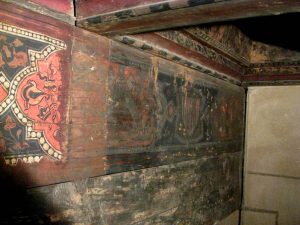
Mr. Hearst’s 15’ x 30’ ceiling had to be configured to fit the 22’ x 45’ Morning Room.
Mr. Hearst’s 15’ x 30’ ceiling had to be configured to fit the 22’ x 45’ Morning Room. Adjustments were calculated by architect Julia Morgan and carried out by artisans who created matching extensions around the perimeter. These were painted with designs loosely based on the motifs of the historic ceiling, but the somber tones were perfectly matched to the old panels, which had darkened with age. Nearly invisible seams and an overall brownish wash made the modern additions almost impossible to discern from a distance.
After cleaning was completed, however, the brilliant reds and whites of the original ceiling emerged. These have been retained because few early 15th-century Spanish painted ceilings have been as well preserved as ours, which is an important specimen in architectural history. This dramatic change of color was an exception at Hearst Castle where the customary objective is, generally speaking, to respect the appearance of a work of art as it was when Mr. Hearst acquired it. To compensate somewhat, the lighting was reduced to soften the impact of the bright hues.

Here, Mr. Hulbert cleans a section added by Mr. Hearst’s workmen. The delineation between the original ceiling and the addition is clearly visible.
By November of 2010, I was fortunate enough to join Mr. Hulbert atop the scaffolding and observe him painstakingly clean a vignette on one of the beams. Watching his cotton swab absorb layers of grime and his surgical scalpel flick away specks of dirt uncovering details not seen in hundreds of years was amongst the most fascinating experiences I’ve had since being affiliated with Hearst Castle.
Thank you Gary Hulbert and Hoyt Fields for allowing me these memorable moments!
***
To learn more about the progress on the Morning Room Ceiling, click here.
To learn more about paintings conservator, Gary Hulbert, click here.
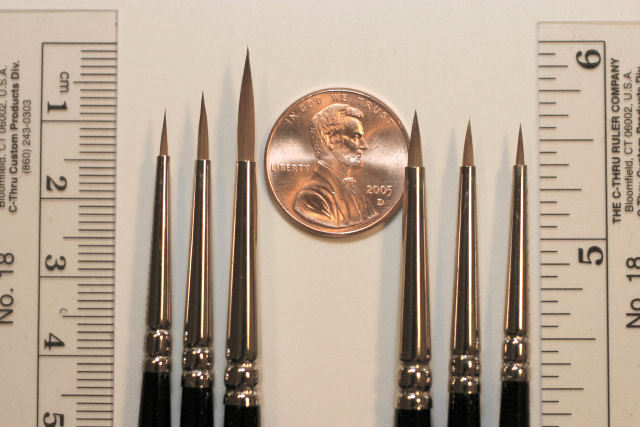
The conservator uses an array of brushes in various sizes to apply adhesive to loose flakes of paint or the delicate process of in-painting.
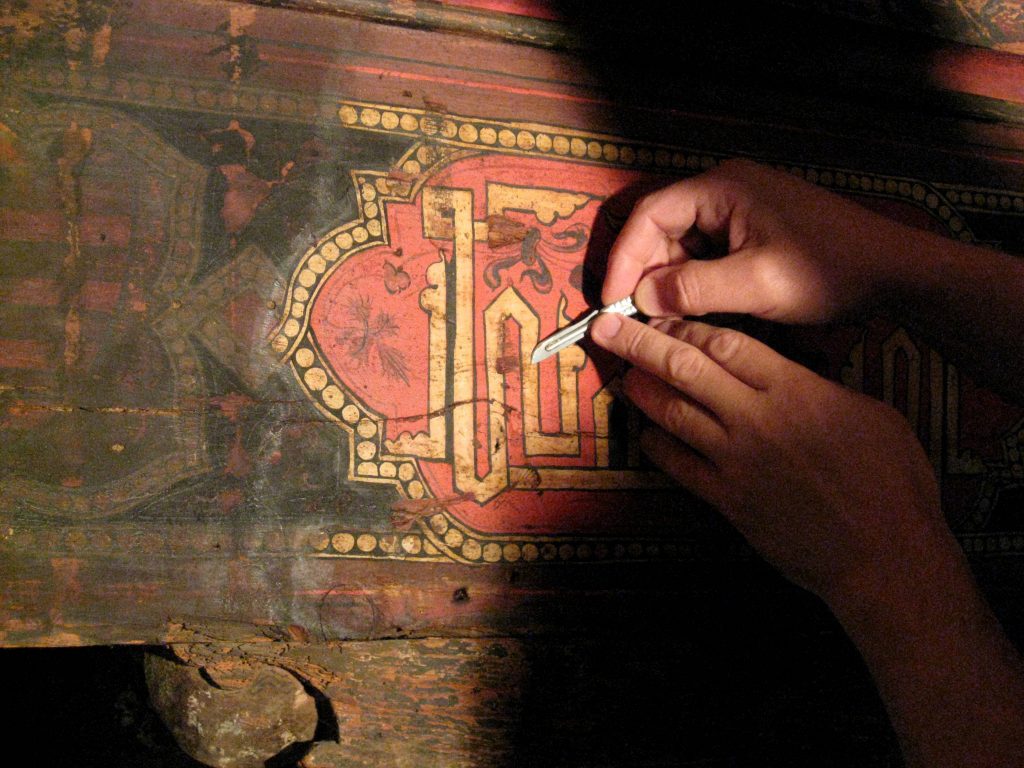
Hand-rolled cotton swabs and surgical scalpels are among the conservator’s tools.

This is a painstaking process carried out with individual cotton swabs which are moistened in a solution of distilled water, various organic cleaners, and other agents that bind with iron and dirt.
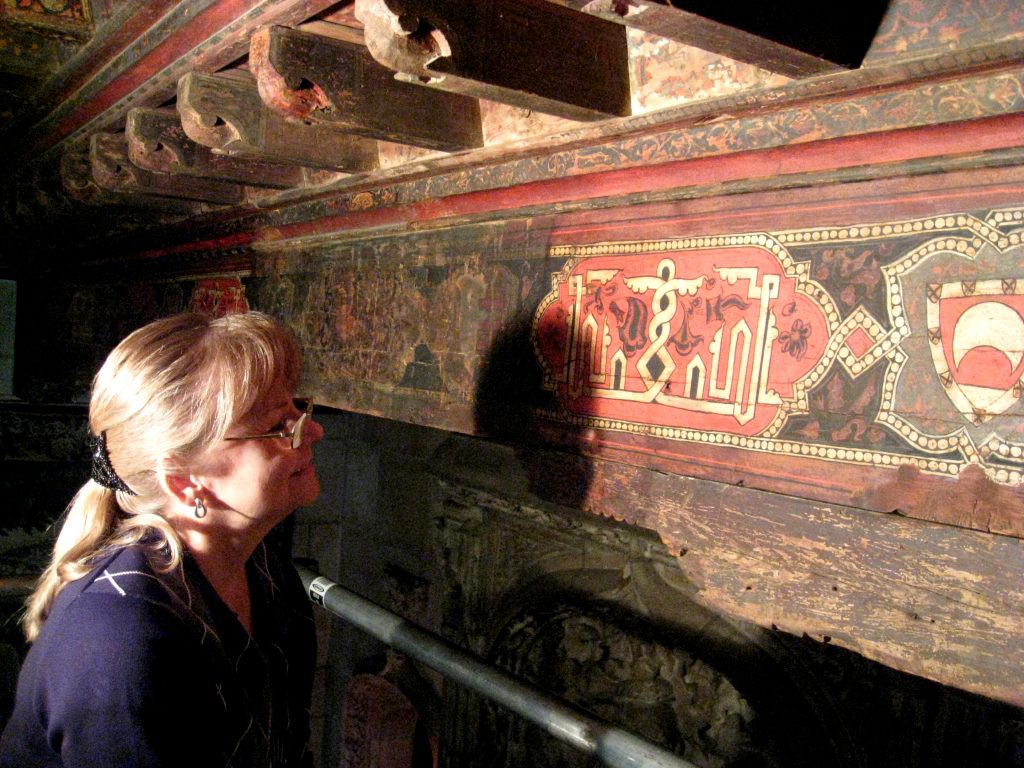
In 2010, I was fortunate enough to join Mr. Hulbert atop the scaffolding and observe him painstakingly clean a vignette on one of the beams.
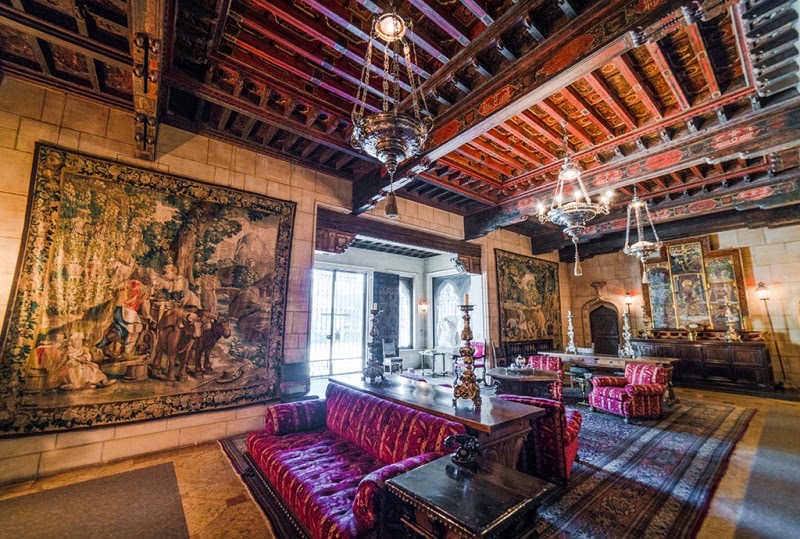
An expansive view of the historic Morning Room Ceiling after treatment.
Glossary
Egg Tempera |
A permanent, fast-drying, water-soluble paint made of colored pigments mixed with egg yolk as a binder. Tempera paintings are very long lasting, and examples from the first centuries AD still exist. Egg tempera was the primary medium for easel-paintings and altarpieces until around 1430, when it was superseded by oil paint. ing. Tempera would be used for frescoes for many years after this. |
Gesso |
Italian for “chalk.” A powdered form of calcium carbonate. In the past it was mixed with animal glue, usually rabbit-skin glue, as a binder and used as an absorbent primer on wood panels and sculptures before they were painted with tempera. Because of its brittle nature, gesso was not generally used for priming canvas. Modern gessoes are suitable for priming canvas because of the addition of latex and other chemicals that ensure flexibility. |
Linseed Oil |
Also, known as flaxseed oil, Linseed oil is obtained from the dried seeds of the flax plant. Due to its polymer-like properties, linseed oil can either be used on its own or blended with other oils and resins. It is used as a varnish in finishing wood, as a binder for pigments in oil paints, as a plasticizer and hardener in putty and in manufacturing linoleum. The use of linseed oil has declined over the years because of the increased popularity of synthetic resins that resist yellowing. |
Mudéjar |
Pronounced moo-DAY-hahr. Refers to a type of ornamentation and decoration used in the Iberian Christian kingdoms, primarily in the 13th, 14th and 15th centuries though it continued being used as late as the 18th century. It was applied to Romanesque, Gothic, and Renaissance architectural styles as constructive, ornamental and decorative motifs derived from those that had been brought to or developed by Muslims in Al-Andalus. Mudéjar was originally the term used for Moors of Al-Andalus who remained in Iberia after the Christian Reconquista but were not initially forcibly converted to Christianity or forcibly exiled. The word Mudéjar references several historical interpretations and cultural borrowings. It was a medieval Castilian borrowing of the Arabic word Mudajjan مدجن, meaning “tamed”, referring to Muslims who submitted to the rule of Christian kings. Read more. |
PVA (polyvinyl acetate) |
A rubbery, synthetic polymer adhesive that first became widely used in the 1940s when it replaced glues made from animal hides. PVA emulsions are used as adhesives for porous materials — particularly wood, paper, and cloth. As a wood adhesive, it is known as “white glue” as well as yellow “carpenter’s” glue. |


